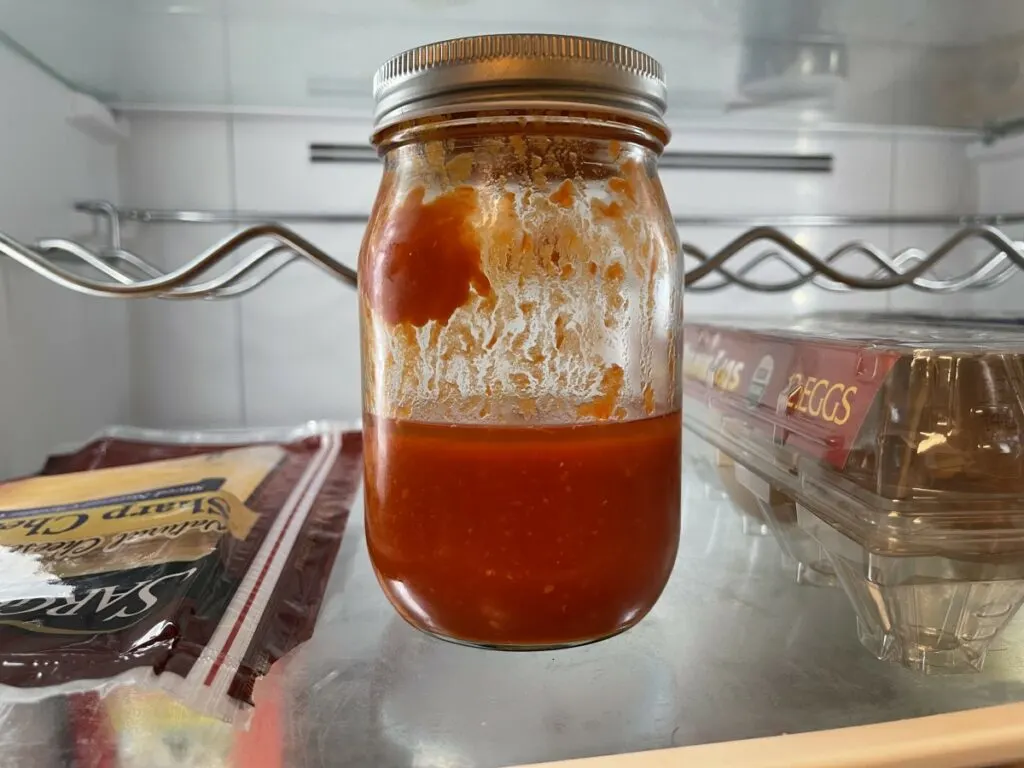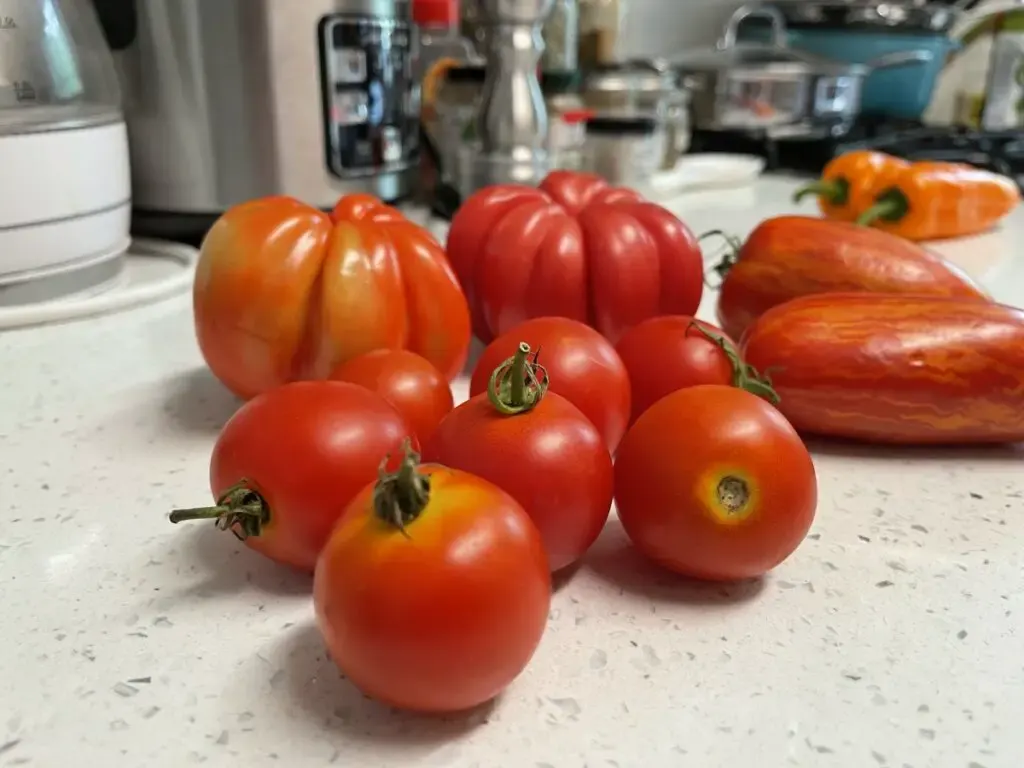Water-based liquids and oils don’t mix, which is a problem when you prepare homemade hot sauces because both are used in most recipes. No one wants hot sauce that separates after storing it, so how can you prevent it from separating?
You can use several ingredients from your kitchen to emulsify hot sauces, like mustard, arrowroot, and chia seed powder. You can also use food additives, like soy lecithin, pectin, and xanthan gum. Making your hot sauce thicker and using fewer fluids can prevent separation.
In this article, we will discuss seven ways to prevent your hot sauce from separating because of the water and oil used in the recipe. After all, much love and effort go into preparing homemade hot sauce, so you want it to look and taste great!

Why Hot Sauce Separates
Typical hot sauce is made with chili peppers, seasoning, vinegar, and sometimes a sweetener. Chili peppers contain natural oils, and when combined with vinegar, the resulting liquid will separate. As mentioned, oils don’t mix well with water-based ingredients, so you’ll need to add some emulsifier to keep your hot sauce together.
1. Make Your Hot Sauce Thicker
Thicker sauce generally has less liquid, so if you find that your sauce is separating too much or if it’s too watery, you might try making a new batch of sauce with less vinegar or water. However, if you’ve already put too much liquid in your sauce, don’t throw it out just yet, as you might be able to cook it down a bit.
You also might find that a thicker sauce needs fewer emulsifiers, which we discuss later in the article.
Use Less Vinegar or Water
Vinegar is a water-based liquid, so vinegar and water will separate from oily substances in your sauce. When you use fewer water-based liquids, it will prevent significant separation in the sauce.
Peppers are about 88% water, so your hot sauce will be liquid when mixed. There’s no need to add a lot of extra fluids, but it’s entirely up to you how you like the consistency of your hot sauce.
If you like a smooth, very liquid sauce, you might have to use more water and vinegar. You could instead cut down on the amount of oil you use in the recipe, which will have the same effect.
Reduce Your Hot Sauce Over Heat in a Saucepan
If you’ve added too much liquid, don’t fret, you can still save your sauce. Allow your sauce to come to a simmer on the stove, and keep it there until the liquid boils off. Your sauce will thicken as the water boils off.
The heat also breaks up the oil used in your recipe and allows it to better mix with the other ingredients. Reducing sauces not only reduces the liquid, but also helps to enhance the flavor, giving you a delicious hot sauce with minimal separation.
2. Xanthan Gum
Xanthan gum is another water-binding agent, as it absorbs water, which can thicken your sauce and prevent it from separating. To use this correctly, you’ll need to sprinkle a small amount in your sauce and mix thoroughly.
Don’t use too much xanthan gum at once, though, or you’ll end up with sludge.
You can often find this additive on the ingredients list in many processed foods AND, surprisingly, in many industrial products. It’s also an ingredient of many body care products, including toothpaste. This might worry you, but xanthan gum is completely safe for consumption and approved by the U.S. Food and Drug Administration.
The additive does not have any nutritious value, unlike other thickeners like lecithin and arrowroot.
3. Mustard
Surprisingly, dry mustard is an excellent emulsifier. But, you’ll have to keep the taste in mind when using it.
Mustard has a robust, overpowering, and particular taste, so if you’re not the biggest fan of the taste of mustard, keep in mind that it won’t neutralize in your sauce. People will know you used mustard, but that may be exactly what you want, especially if that’s your intention with your hot sauce recipe.
Mustard can be extremely spicy, depending on the brand and the amount you use in your recipes.
If your sauce is already very spicy or just the right amount of spice, you probably shouldn’t use mustard as an emulsifier. Don’t worry, however, because other options are coming up in the article for you to experiment with. You’ll figure out what works best for you.
4. Arrowroot
Because arrowroot has emulsifying properties, it’s a great ingredient to use in your hot sauces. It absorbs water, which allows water to bond better with oily substances.
It’s a natural ingredient, often used in body products for its thickening properties.
Arrowroot is safe for consumption, very nutritious, and has a bland taste, so don’t worry about it affecting the taste of your hot sauce. But, if you’re thinking about making a dairy-based hot sauce, which is rare, you’ll want to use other emulsifiers instead, since arrowroot tends to create a slimy sauce when dairy products are introduced.
5. Pectin
Pectin is a binding agent that works as a thickener and stabilizer, so it’s a great food additive to help you prepare the hot sauce you want. You can use beet and citrus pectin as emulsifiers.
While pectin is primarily found in the peel or outer layer of fruits, you can usually find pectin powder in most supermarkets.
Pectin can cause some health problems if you consume too much of it. You might want to avoid the additive in your food, however, if you have serious digestive issues. However, since you’d only be consuming small amounts of pectin when you use it in hot sauce, you should be alright.
You can even add pectin to the hot sauce with dairy products without affecting the sauce’s texture, unlike arrowroot. It should be tasteless, but it always depends on the brand you’re buying from.
6. Chia Seed Powder
Chia seeds are highly absorbent and can double in size when allowed to soak in water, which makes them a great thickener and emulsifier. You can also grind the seeds into a powder before using them in your hot sauce if you don’t want the seeds to change the texture of teh sauce.
When in contact with water, chia turns to gel, making it a perfect thickener for your sauces. Using the substance as an emulsifier can slightly alter the texture of your sauce. It also has a subtle taste, but the spiciness of your sauce should overpower that.
You can find chia seeds in most grocery stores, but chia seed powder can be a little bit harder to find. Grinding chia seeds is pretty easy, as the seeds are very dry, so you can just use your blender or a spice grinder.
7. Soy Lecithin
Not all lecithin comes from soy. It can also come from eggs or rice. The substance is naturally present in the body, and consumption of lecithin might improve brain health and support other organs, like your heart, liver, and skin.
You can usually find soy lecithin in the grocery store in liquid and powder form, as well as in supplement form if you want to buy it to improve your health.
Lecithin works as an emulsifier in foods with oil and water-based ingredients. You only need a small amount of it to prevent your hot sauce from separating.

Bonus: Add Fibrous Vegetables to Your Hot Sauce
You can add more fibrous vegetables to your hot sauce to make it thicker, like carrots, sweet potatoes, and spinach.
Here are some examples of hot sauce recipes that you can make with vegetables:
- Add cooked carrots to make an orange hot sauce.
- Cooked spinach, combined with Jalapeño peppers, can create a great green hot sauce.
- Corn can give your hot sauce a Tex-Mex flavor. This sauce might go well with your tacos or enchiladas.
- Green chilis, tomatoes, and onions can give your hot sauce a salsa flavor without the added chunks that salsa has.
There are some great recipes with vegetables for homemade hot sauce, so if you’ve been experiencing some issues with emulsification, maybe you can switch it up a bit. We always mix up our hot pepper with some mild versions, and have also experimented with adding roasted onions to great effect in our homemade hot sauces.
Mix, Whisk, or Shake Before Use
This method isn’t a prevention method, but it’s a great way to fix a sauce that has already separated. You can either shake your sauce before each use if it’s in a bottle, or if you have a large amount, you can put it in a bowl and, using an electric mixer, blend the sauce until it’s emulsified.
When using this technique, however, garlic and olive oil can start to taste more bitter when mixed on high power. This can completely alter the taste of your hot sauce, so if you don’t want that, don’t mix the olive oil and garlic.
